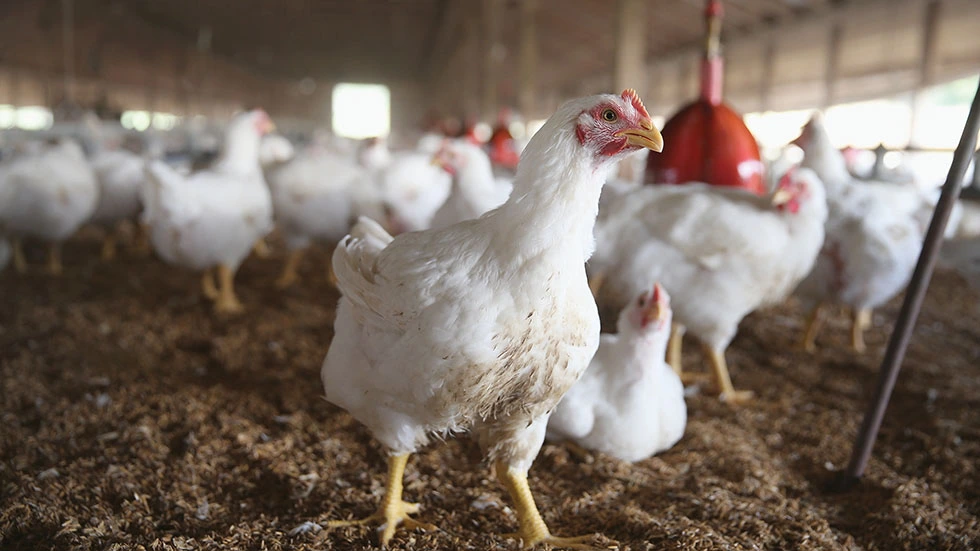In his recent op-ed for The Hill, “Solutions in search of problems — USDA’s unnecessary intrusion into chicken industry,” National Chicken Council President Mike Brown attacks food safety and labor advocates, calling them a front for “radical activists” seeking “the end of animal agriculture.” But protecting consumers, farmers, and slaughterhouse workers from the chicken industry’s abuse is far from radical.
Consider food safety. Chicken may seem cheap, but when you factor in the cost of foodborne illness, consumers are getting a raw deal. Chicken makes more people sick than any other category of food products, in part because salmonella contaminates about 1 in every 25 packages of chicken at the grocery store. Some of this salmonella is extremely virulent. Just a few cells or “colony forming units” of the bacteria — few enough to be transmitted in a drop of meltwater from a thawing package of chicken breast — could cause serious illness or even death, particularly among very young, very old and immunocompromised consumers.
No one should have to wear a hazmat suit to prepare dinner. If chicken companies were more likely to be held liable for a foodborne illness outbreak, they would invest more in product safety. Under the current U.S. Department of Agriculture (USDA) rules, there is nothing to stop a company from knowingly selling chicken contaminated with even high levels of the most virulent, antibiotic resistant salmonella. What’s worse, USDA’s dysfunctional regulations can make the situation worse, giving companies an incentive, for example, to develop vaccines against common but relatively harmless salmonella strains, which leads to more products contaminated with the strains that tend to cause illness.
This sad state of affairs has led several leading poultry companies to join forces with consumer advocates and academic experts in calling for enforceable product standards for poultry. USDA recently proposed such standards for a narrow range of products — frozen breaded raw chicken, which many consumers mistake as cooked. After the Canadian government adopted a similar policy for these products in 2019, salmonella infections dropped 16 percent, an astounding result given what a tiny share of the retail poultry market these products represent. USDA regulators can hardly be blamed for wanting to adopt this type of highly cost-effective reform.
Nor should anyone fault USDA for trying to protect contract chicken growers. While Brown would have you believe chicken companies favor their contract chicken growers over their shareholders, insulating the growers from the market, in fact chicken production is organized to use corporate power against farmers, turning them into modern day serfs. Chicken growers typically take out more than $1 million in loans to build poultry houses to companies’ specifications. They’re responsible for cleaning up the massive amounts of waste the chickens leave behind — rendering their mortgaged property unusable for nearly any other tasks.
The grower has no choice to whom he will sell the birds, and the companies pay the growers based on a “tournament” in which the growers compete against the others who have delivered birds that week. Through selecting who is in tournament, which chicks they get, and what sorts of care those chickens receive (which the industry also controls), the companies pick winners and losers. As a result, growers are frequently unable to repay their debts, forcing them to constantly renew their contracts and serve the company. An estimated 71 percent live below the federal poverty line.
USDA has proposed rules and suggested more are coming, aimed at some of the worst abuses of the contract poultry grower system. The rules would require poultry integrators to be transparent with prospective and current contract poultry growers about contract terms and the real incomes they are likely to earn. They would also prohibit the deceptive contracting practices used by corporations to lock growers into their system, increase protections against discrimination and retaliation against the growers, and (we hope) provide growers rights against the unfair and unreasonable corporate abuses that have plagued agriculture since Upton Sinclair. These are measures that Americans across the political spectrum support.
The same applies to reforms needed to protect workers in poultry plants. Poultry plants are among the harshest working environments in U.S. manufacturing. Amputations in poultry workers are almost five times the average for all industries, and government studies have documented alarmingly high rates of carpal tunnel syndrome — as high as 42 percent — among workers in chicken processing plants. A typical poultry worker handles dozens of birds per minute. The conditions have resulted in an average employee turnover rate of 60 percent.
The faster the line speed, the greater the risk of harm. Nevertheless, the USDA has bowed to industry pressure to lift line speed caps, allowing some plants to operate lines as fast as 175 birds per minute, despite criticism from outside the agency. Last July, the USDA announced that it would require these plants to participate in a study on the effects of increased line speeds on worker safety. The results are not yet in from that study, but the USDA has shown little inclination to abandon the higher line speed program. That’s unfortunate because the study is likely to arrive at similar conclusions as previous studies: Poultry workers need better protections, including line speeds that do not put workers at risk.
Americans love chicken, it’s true. But they also love justice, and fairness. USDA’s reforms will not stop Americans from eating chicken, but they will help us to feel better about it.
Thomas Gremillion is Director of Food Policy at Consumer Federation of America, David S. Muraskin is Food Project Litigation Director at Public Justice and Debbie Berkowitz is Practitioner Fellow at the Kalmanovitz Initiative for Labor and the Working Poor, Georgetown University. She was a former senior official at OSHA.




